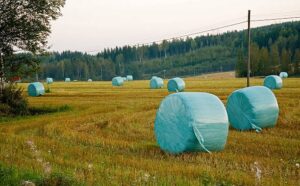In the vast expanses of Australian agriculture, where the land often dictates the success of farming endeavours, the preservation of forage crops is paramount. Silage, a staple in livestock feed, undergoes a transformation from freshly cut forage to preserved, nutrient-rich fodder.
At the heart of this transformation lies silage wrap, a crucial component in ensuring the preservation and quality of silage. In this article, we delve into the evolution of silage wrap in Australia, exploring its significance, advancements, and impact on agricultural practices. For quality air tight silage wrap, click here.
Understanding Silage Wrap
 Silage wrap, also known as bale wrap or baleage wrap, is a specialised plastic film used to encase bales of forage crops, such as grass, maise, or legumes, to create silage. The wrap serves as a barrier against oxygen and moisture, essential elements that can lead to spoilage and nutrient loss in stored forage. By tightly sealing the bales, silage wrap creates an anaerobic environment conducive to fermentation, preserving the forage’s nutritional value and extending its shelf life.
Silage wrap, also known as bale wrap or baleage wrap, is a specialised plastic film used to encase bales of forage crops, such as grass, maise, or legumes, to create silage. The wrap serves as a barrier against oxygen and moisture, essential elements that can lead to spoilage and nutrient loss in stored forage. By tightly sealing the bales, silage wrap creates an anaerobic environment conducive to fermentation, preserving the forage’s nutritional value and extending its shelf life.
The Importance of Silage Wrap in Australian Agriculture
In Australia’s diverse agricultural landscape, where climatic variations and seasonal fluctuations pose challenges to forage preservation, silage wrap plays a pivotal role. Livestock farmers across the country rely on hay as a critical component of their animals’ diets, particularly during periods of feed scarcity, such as droughts or dry seasons. Silage wrap enables farmers to harvest and store forage efficiently, ensuring a steady supply of quality feed year-round. For quality air tight silage wrap, click here.
Moreover, silage wrap offers flexibility in feed management, allowing farmers to preserve excess forage for future use and mitigate feed shortages. Its effectiveness in preserving nutrients makes it an invaluable tool for optimising livestock nutrition and productivity. Additionally, by reducing the need for supplementary feeds, silage wrap contributes to cost savings for farmers, enhancing the economic viability of livestock operations.
Advancements in Silage Wrap Technology
Over the years, advancements in agricultural technology have led to significant improvements in silage wrap design and performance. Modern silage wraps are engineered to provide enhanced oxygen barrier properties, ensuring tighter seals and prolonged preservation of forage quality. These innovations help minimise nutrient losses during storage, maximising the feed value of hay for livestock consumption.
Furthermore, manufacturers have developed specialised silage wraps tailored to specific forage types and storage conditions. From high-moisture grasses to dry haylage, there exists a diverse range of silage wrap options to meet the varying needs of Australian farmers. Additionally, UV-resistant formulations prolong the durability of silage wrap, allowing for extended outdoor storage without compromising efficacy.
Environmental Considerations and Sustainability
In recent years, sustainability has emerged as a critical concern in agricultural practices, prompting a shift towards environmentally friendly solutions. Silage wrap manufacturers have responded to this demand by developing biodegradable and recyclable alternatives to traditional plastic wraps. These eco-friendly options offer farmers the benefits of silage preservation while minimising the environmental impact of plastic waste. For quality air tight silage wrap, click here.
Furthermore, proper management of silage wrap disposal, such as recycling programs or on-farm recycling initiatives, can further reduce its environmental footprint. By implementing responsible waste management practices, farmers can contribute to a more sustainable agricultural ecosystem while reaping the benefits of silage preservation.
Maximising Silage Quality: Tips for Australian Farmers
Achieving optimal silage quality is essential for livestock farmers seeking to maximise their animals’ nutrition and performance. In Australia’s dynamic agricultural landscape, where climatic variations and seasonal challenges abound, implementing effective silage management practices is critical to success.
First and foremost, it is crucial to select high-quality silage wrap suited to the specific forage type and storage conditions. Investing in UV-resistant and oxygen-barrier formulations can prolong silage freshness and minimise nutrient losses.
Additionally, proper bale packing and sealing techniques ensure airtight storage, preventing oxygen ingress and spoilage. Regular monitoring of bale density and wrap integrity helps identify potential issues early, allowing for timely adjustments and interventions.
Conclusion
Silage wrap stands as a testament to the ingenuity and innovation driving Australia’s agricultural sector forward. From its humble beginnings as a simple plastic covering to its current state-of-the-art formulations, silage wrap has revolutionised forage preservation, enabling farmers to overcome challenges and maximise productivity.